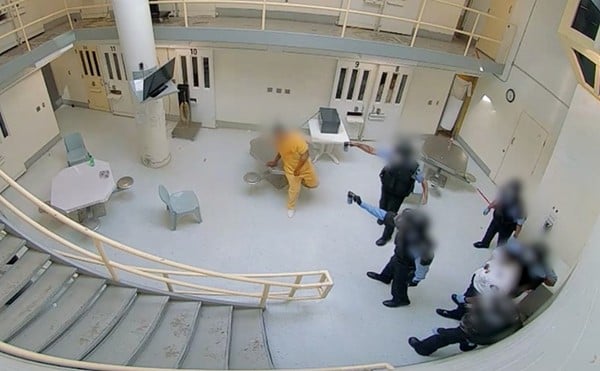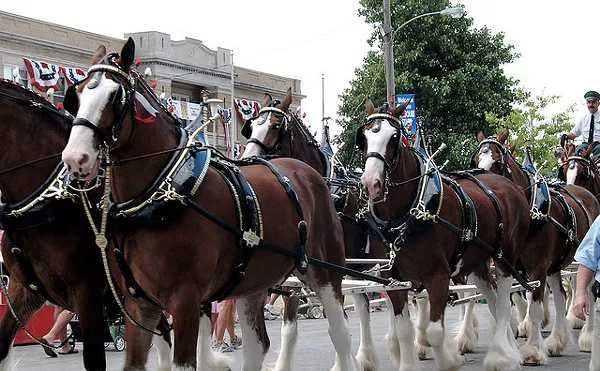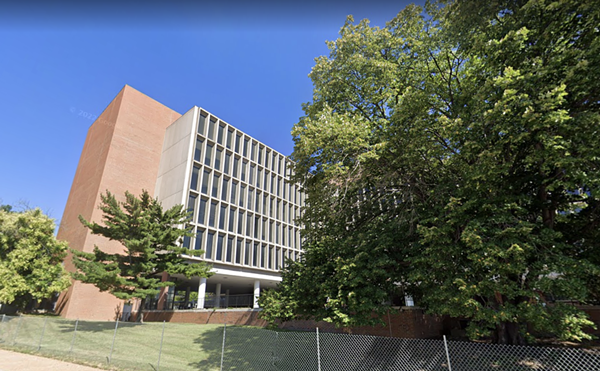As Joseph Lane watched the assault, he thought the young man might die of his injuries. Garcia, an 18-year-old high-school student from Arnold, begged for his life, says Lane, as his attackers continued to bludgeon him with flashlights and truncheons.
Lane couldn't call the police for help, because the police were already there -- they were the perpetrators of the beating.
"For a half-a-block, they literally kicked and beat this kid and kept spraying him with Mace," says Lane, a 46-year-old organic gardener from Chesterfield. "He couldn't see. He was blind. He couldn't walk. He couldn't do anything."
When Lane implored the cops to stop the senseless battery and complained that the victim's civil rights were being violated, one of the officers turned on him. After repeatedly dousing him with a chemical spray, Lane says, the officer sarcastically asked him: "Now what do you think of your fucking civil rights?"
Garcia -- the first victim -- was charged with second-degree assault against a law-enforcement officer (however, the charge was later dropped). The incident is one of many acts of police violence that reportedly occurred last Tuesday night after the annual Light Up the Night Fat Tuesday Parade in the Soulard neighborhood. None of the attacks appears to have been random or spontaneous in nature. On the contrary, it seems the police participated in an organized assault on the crowd, using indiscriminate force to clear the streets. St. Louis Police Chief Ronald Henderson -- who commanded his ranks on the scene -- denies that the department used any inappropriate or excessive measures.
"The judgment was made not from my desk -- I was out there with the officers the whole time," says Henderson, who facetiously refers to the Mardi Gras mayhem as the "love fest." Last Friday, Henderson expressed confidence in himself and the behavior of the officers under his command: "I think the crowd was getting out of control and something needed to be done to take control, and that's what we did. If the police would have done nothing, the headlines would have read that we stood by and let them destroy the neighborhood and took no action."
Interviews with paradegoers indicate the police incited the raucous revelers to riot, however. By all accounts, the center of the disturbance was located around the intersection of Ninth and Geyer streets, adjacent to the 1860's Hard Shell Cafe and Bar. Thousands of celebrants, many of them intoxicated and underage, were drinking in the street. The crowd became more enlivened when a number of young women, who had been hoisted onto the shoulders of their male companions, exposed their breasts. In exchange for displaying their mammary glands, the women were showered with souvenir necklaces. The exhibitionism is a relatively innocuous Mardi Gras tradition. Witnesses described a boorish but mostly amicable throng.
But the spirit of the gathering changed sometime between 9 and 10 o'clock, after one or more motorcycle police officers drove into the middle of the revelers, causing people to stumble and fall over each other.
"They (the motorcycle police) went right through the crowd," says 23-year-old James Chrismer, who accompanied Lane to the event. Chrismer, who says he was trained in crowd control in the Marine Corps, thinks the police mishandled the situation. "There was just nowhere to go. There were young people there getting trampled," he says. "They just started bum-rushing people." In the pandemonium that followed, rowdies pummeled one motorcycle cop and damaged at least three vehicles parked along Geyer Street.
Ken "Elvis" Picker says that when he and a friend tried to aid a waitress who was trapped inside her car, two officers manhandled them. The incident occurred outside of Molly's bar. "The police smacked the guy who was in the parade with me in the mouth, backhanded him," says Picker. "The police officer on my side poked me in the chest." Vandals then smashed the windshield of the vehicle and dented its hood. Instead of arresting the responsible parties, the police themselves went on a rampage.
"Basically, they were out of control; they just weren't acting professional," says Paul Smith, referring to the police. Smith, a 30-year-old Englishman who is visiting friends in Soulard, attended the famed Carnival in Brazil last year. But his Latin-American experience didn't prepare him for the way St. Louis' finest chose to honor this year's pre-Lent fete. "The police were just spraying Mace indiscriminately -- they were really assholes," says Smith. "They were making the problem spiral. They were aggravating people rather than calming." Instead of "pulling the troublemakers out, they were running around knocking people in the head."
Asked why the police had not been more tactful in removing the rabble-rousers, Henderson scoffs: "Walk through the crowd, cherry-picking them out -- is that what you're saying? Yeah, right. I'd like to see you do that."
Despite Henderson's casual dismissal, continued on next pagecontinued from previous pagethe New Orleans Police Department (NOPD), which oversees the mother of all Mardi Gras celebrations, treats crowd-control situations with more discretion. "Once you see a problem in the crowd, you go in, you extract the problem and you leave," says Lt. Marlon Defillo, a spokesman for the NOPD. "You still monitor and observe, but you don't go into the heart of the crowd and stay an hour, trying to deal with the situation. We find that staying in a dense crowd, to deal with a situation, prolongs it. It tends to antagonize or create more problems."
"The key is high tolerance," adds Defillo. "You have to recognize that people are gathering to socialize and to be involved in a festive activity," he says. "If persons are chanting, or yelling obscenities, maybe that's the way they express having a good time. You are there, basically, to assure that peace is maintained. As long as folks are not infringing upon the rights of others or causing harm or damage to others, you're basically there as an observer."
As for controlling lewd conduct, pragmatism dictates that it be judged on a case-by-case basis. "You have to weigh the whole situation," says Defillo. "If it's not feasible to get through the crowd, you're going to cause more problems trying to get to the problem. You have to use good judgment."
Whereas there appears to have been a dearth of good judgment in Soulard last Tuesday night, there is no indication of a similar paucity of chemical-warfare agents, or the will to use them, on the part of the police. "You wouldn't believe how many little girls, 15-16-17 years old, that I saw who were beat and Maced," says Lane. Two other witnesses independently corroborated Lane's allegation concerning the chemical spraying. To his knowledge, Defillo says, the NOPD has never used chemicals such as Mace to quell disturbances at Mardi Gras festivities.
After the motorcycle-cop fracas, the police reacted quickly with a three-pronged attack, according to witness accounts. First came a corps of officers, wielding billy clubs and flashlights, repelling the crowd with chemical sprays; then the mounted patrol, a virtual cavalry, used the hooves and flanks of their horses as weaponry; finally, a phalanx of mobile reserve officers in full riot regalia, including helmets and shields, swept up Geyer Street. In a very real sense, the objective of the maneuver was to take no prisoners. Instead, the police seemed set on dispersing the inebriated horde through sheer terror. Anyone too drunk or confused to understand those conditions risked a beating.
Aside from the altercation involving the motorcycle officer and the subsequent property damage to a few vehicles, the most heinous offense among the young revelers appears to have been the baring of several pairs of adolescent teats. With these notable exceptions taken, the only other explicable purpose behind the unreasonable police action would seem to be an attempt to enforce the event's 10 p.m. street curfew, a ridiculous rule in itself.
According to Henderson, however, female torsos were not all that was being flaunted. "They bared other parts of their bodies," says the chief. "I think it tended to psych the crowd; I mean, they were egging on other young ladies to do likewise. It was just a combination of the behavior of the crowd and the demeanor and things that went on. There was property damage; there were concerns for other people that were at the event," says Henderson. "We repeatedly used the megaphone on our car and told them to disperse. Now, if they were in that crowd that was throwing beer bottles, throwing beer and rocks, you know, that was a situation where we had to take control. We didn't just arbitrarily go there and decide to take on the crowd. We ordered them to disperse and gave them ample time to leave."
But Chrismer's and Lane's accounts contradict Henderson's appraisal. "They gave no warning whatsoever," says Chrismer. "Even if you went up to a cop and asked them what they were doing or why they were doing it, they wouldn't tell you anything. They would just point and say, 'Go.' If you didn't go, then they would just start using excessive force."
For those trapped in the crowd, the marching orders were a catch-22. There was no place to go, no escape. "They would beat you and Mace you, and make you go down the street, and you'd get down there and they would beat you and Mace you ... and make you go back the other way," says Lane. "It was nuts. It was just out of control. Their command center had no idea what was going on. It was the stupidest thing I've ever seen."
As the crowd scrambled to avoid the converging police lines, chaos ensued. People grappled with one another to break clear of the approaching menace. In the tumult, 18-year-old Randy James of Pacific somehow sustained a 3-inch fracture to the base of his skull, according to published reports. His companions, who found him lying on the ground, don't know whether to place the onus directly on the police or on others in the crowd. James can't recall what happened, because the blow to his head has caused memory loss. He discharged himself from St. Louis University Hospital on Friday.
On Monday, Adella Jones, a police-department spokeswoman, confirmed that 27 individuals were arrested on a total of 36 charges ranging from peace disturbance to second-degree assault against a police officer. The department reported last week that an additional 57 minors had been cited for underage drinking.
The department is refusing to make public the number of officers who were assigned to the Mardi Gras detail last Tuesday night, Jones says. To date, three formal complaints have been lodged with the department's internal-affairs division, she says. Other than that, the department is not delving into the matter any further. "There is no other investigation," says Jones.
Garcia, one of those arrested, called the RFT from St. Anthony's Medical Center last Friday, where he had gone to pick up his medical records. He said his next stop that afternoon would be the police department's headquarters downtown, where he planned to meet Lane and file a formal complaint with the internal-affairs division. Lane said Monday that Garcia had identified his main assailant, and he's the same officer who arrested Garcia.
"They held my mouth open and sprayed Mace in my mouth," says Garcia. "My mouth and my tongue are pretty raw from it still. They sprayed me severely with Mace in my eyes. They just kept beating up on me. I had knots on my head, where they kicked me. I passed out for two or three seconds. My ribs are still swollen from where they hit me with their billy clubs. I had a big thick coat on, and that's what the doctor said saved me a lot, too."
"They charged me with throwing something at a cop," says Garcia. "I never touched any of those officers, my friends saw that. "I've got a bunch of recommendations from my school saying I'm a good kid -- never been in a fight, never been suspended."
In this case, the laurels for the police may be more difficult to attain.





